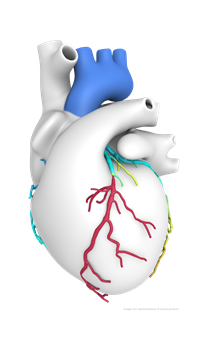 Patients with coronary artery disease (CAD) are benefiting from an advanced technology available at Houston Methodist Sugar Land Hospital that can accurately model blood flow to the heart and reduce the need for invasive procedures.
Patients with coronary artery disease (CAD) are benefiting from an advanced technology available at Houston Methodist Sugar Land Hospital that can accurately model blood flow to the heart and reduce the need for invasive procedures.
The HeartFlow® Analysis uses data gathered during a routine CT scan to create a computerized, color-coded, 3D model of the patient’s heart and associated blood flow, giving physicians a detailed look at both the location of artery blockages and their exact impact on the heart.
In the past, patients with chest pain were given a cardiac stress test followed by a traditional CT scan that might indicate coronary artery disease but could not conclusively prove that there were significant blockages. That required an invasive angiogram, in which a catheter is threaded through the groin to administer a contrast agent that can be seen by X-ray, allowing physicians to observe the patient’s blood flow.
“The new imaging technology is extremely valuable in helping us to more accurately diagnose patients with clinically significant coronary artery disease and thus determine the most appropriate course of treatment based on their unique needs,” said Eric Longo, M.D., board-certified radiologist and Chair of the Department of Radiology at Houston Methodist Sugar Land. “With the HeartFlow 3D analysis, we can examine each point in the coronary anatomy to identify and locate lesions that are likely to cause ischemia, or inadequate blood flow, without the need for an invasive diagnostic coronary angiogram.”
Coronary heart disease is the most common form of heart disease in the U.S., affecting more than 15 million Americans. Blockages in the blood vessels that supply blood to the heart increase a patient’s risk of heart attack, and common symptoms include chest pain or tightness, shortness of breath and heart palpitations.
A recent study of nearly 400,000 patients at 650 U.S. hospitals found that 55 percent of patients who underwent an invasive angiogram had non-obstructive coronary artery disease, meaning there were no significant blockages requiring intervention.
“HeartFlow 3D analysis aims to decrease unnecessary invasive diagnostic angiograms so other forms of treatment in patients with non-obstructive coronary artery disease can be expedited and the inherent risks associated with conventional angiography may be avoided,” said Dr. Longo.

Leave a Reply